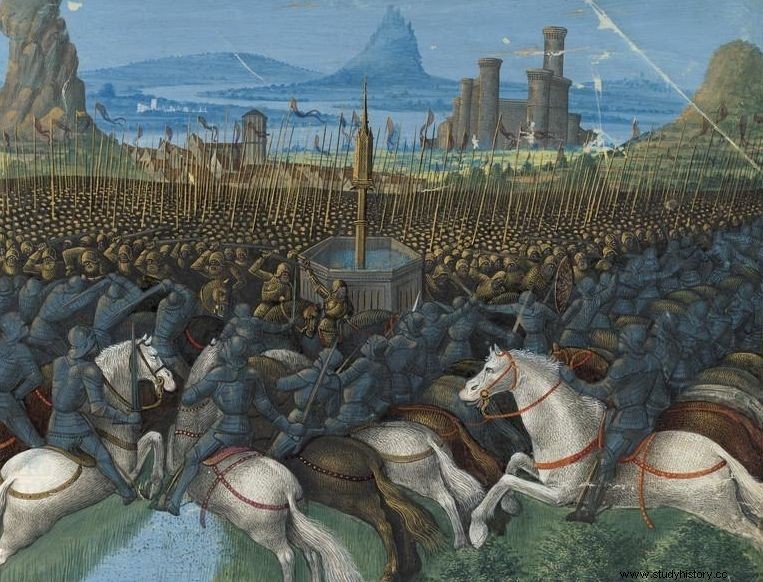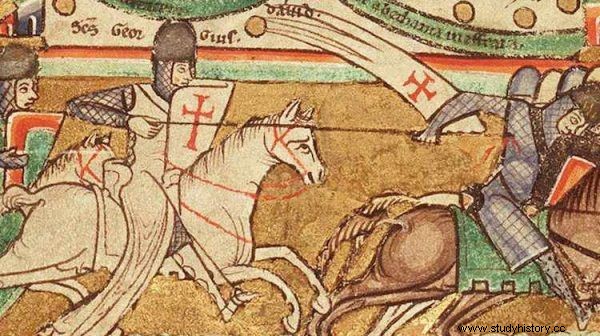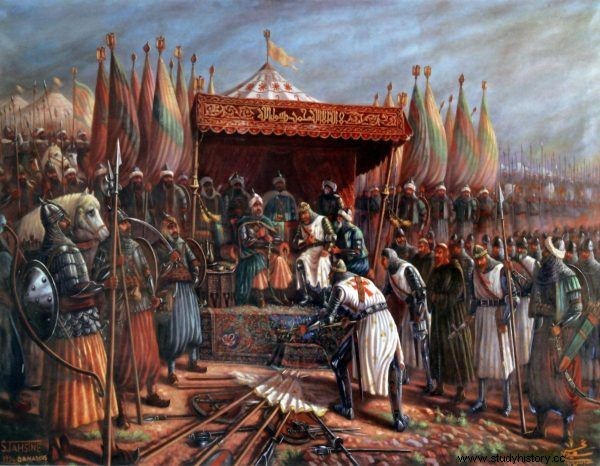In this clash, as a result of the astonishing recklessness of the commanders, the largest army ever raised by the crusaders suffered a crushing defeat. It resulted in an unimaginable thing - Muslims captured Jerusalem. What exactly happened under Hittin?
In the spring of 1187, the ruler of Syria and Egypt, Sultan Saladin began preparations for a great military expedition against the Crusader states in Palestine. He mobilized his subordinate peoples, drawing warriors from all parts of his country. Turks, Arabs, Kurds and Egyptians showed up at Damascus.
Twelve thousand heavily armed horsemen arrived, who were able to hold on to the battle-hardened Western knights. In addition to them, 8,000 experienced infantry appeared, as well as a large number of volunteers, called muttawija . Historians estimate that in total Saladin amassed from 30,000 to 40,000 soldiers.

15th century depiction of the Battle of the Horns of Hittin.
As one Latin chronicler wrote:the ruler had amassed a force as numerous as "the sands of the seashore" . The goal of this strong army was to crush the face of the unfaithful Franks that stretched along a narrow strip along the Mediterranean coast.
Saladin starts a jihad
Saladin, or Yusuf Salah al-Din, was intelligent and quick-witted since he was a child. He was interested in science, art and medicine, he liked to talk to scholars and artists. He kept himself at least seemingly away from the military. However, he distinguished himself in the service of the ruler of Syria, Nur al-Din, and during his expeditions to Egypt, he unexpectedly showed extraordinary military talent.

Saladin displayed extraordinary military talents.
He became a vizier there, and after the death of Nur al-Din, he subjugated the Muslim states in the Middle East:from Egypt in the south to Syria in the north. The Caliph of Baghdad then awarded him the title of Sultan. Saladin created an empire that could threaten the very existence of Latin states in the Holy Land. This was also his goal: the ruler declared a holy war against the infidels .
Meanwhile, in 1186, as a result of a series of intrigues, Gwido of the Lusignan family, a French feudal, widely recognized as a mediocre ruler and commander, became king of Jerusalem. He was a supporter of a tough policy towards the followers of Islam. He was supported in this by the Grand Master of the Templar Order, Gerard of Ridefort, a hot-tempered and combative man (even suspected by historians of a mental illness), and the local warlord Reginald of Châtillon, constantly waging wars with Muslims.
The opponents of the "hawks" party they created were the so-called pullanie, that is, supporters of maintaining good relations with Saladin. They were led by Count Raymond of Tripoli and Balian of Ibelin. The former was a reasonable and experienced man. Appreciating the political and military talents of his opponent, he prudently concluded a truce with him. He also tried to secure the support of the Sultan in his efforts to gain the royal throne. These contacts made Jerusalem suspect him of treason. They also indirectly caused the war to break out.
The Grand Master makes war
Here in April 1187 Saladin asked Raymond to agree to the march of the Sultan's reconnaissance detachment through his own Galilee. Raymond agreed, but on condition that the unit will cover the there and back route in one day and will not cause any harm to the residents . After the conclusion of the contract, the count sent messengers to his estate with the news of the march, ordering his subjects to stay at home. Thus, on May 1, a 7,000-strong Mamluk squad crossed Jordan.
It was unfortunate that at the same time a delegation sent from Jerusalem by King Guidon to talk with Raymond was going to the castle of La Fève, on the plain of Esdrelon. It included, inter alia, the Grand Master of the Templars Gerard of Ridefort, the Grand Master of the Knights Hospitaller Roger of Moulins and Reginald of Châtillon. When Gerard found out (by the way from Raymond's messenger) about the Saracen march, he considered it another proof of the count's treachery and decided to act.
He called for reinforcements from nearby strongholds and struck many more Mamluks who were sipping their horses in a pool at a place called Cresson Spring. The effect of the clash was predictable:Saladin's select warriors massacred the Knights Templar and the Knights Hospitaller. Only three monks survived the battle , including the reckless initiator of the battle .
The battle at the source of Cresson gave the Sultan an excuse to start a war. On June 26, 1187, he concentrated his army, then moved west and entered Christian territory. After crossing the river, Jordan split his forces into two.

The Battle at the Source of Cresson gave Saladin an excuse to start a war against the Crusaders.
One attacked Raymond of Tripoli's Tiberias on the shores of Lake Tiberias, and the other set up camp outside the village of Kafr Sabt, just west of the lake. Tiberias was quickly conquered, with the exception of the citadel there, where Raymond's wife, Countess Eschiv, defended himself. She sent a message to her husband and the king asking for help.
The largest army of the kingdom
Seeing Saladin's preparations for war, Gwido of Lusignian summoned all the vassals of the kingdom with their troops. This is how the mobilization of Christian forces is described by the English historian Paul Hill in his book "The Templars at War 1120-1312":
Templars and Hospitallers also brought their troops, but for this purpose the Knights of the Temple had to strip their garrisons in the kingdom. However, they also brought back the money they had received from the amount Henry II, King of England, paid as penance for the murder of the Archbishop of Canterbury, Thomas Becket. At the end of June 1187, the Christian forces numbered 1,200 knights, an unknown number of turcopoles [local light weir - ed. PS] and about 10,000 infantry.
It was the largest army the Kingdom of Jerusalem had ever raised . It was camped in the town of Sepphoris, about halfway between the coast and Lake Tiberias. There was then a dispute among the rulers of the kingdom over the plan of action. Most urged that they go to the relief of Tiberias immediately. The main supporters of quick action were, of course, Grand Master Gerard of Ridefort and Reginald of Châtillon.
On the other hand, Raymond of Tripoli called for the avoidance of hasty decisions. He reasonably argued that a long walk in heat and difficult terrain conditions would not be a good idea. It is better to stay in the camp in Sepphoris, which is stocked with water and food, and wait there for the enemy's reaction. When his stepchildren urged him to help his mother, he replied that he would rather lose Tiberias than risk the entire kingdom. This bold declaration cooled the hot heads and it was decided to stay in the camp.

The largest army in the history of the Kingdom of Jerusalem stood at Hittin. The Templars could not be missing among the fighters.
However, during the night, the situation changed unexpectedly. A well-known supporter of radical solutions, Grand Master Gerard of Ridefort, appeared in King Gwidon's tent and persuaded the ruler to change his mind. He accused Raymond of treason. "Lord, do you believe this traitor who gives you this advice?" He asked, and it was like the truce of the Count with Saladin. He also argued that the Templars must avenge the defeat at the source of Cresson. The weak monarch was persuaded and in the morning to everyone's surprise he ordered to go to Tiberias. It was a mistake that soon took harsh revenge on the Latin knights.
Pogrom in the Horns of Hittin
The camps were left in the camp, and the army was divided into three columns. Inside each was a cavalry, surrounded on the outside by foot. As the author of "Templars at war" writes:
As per Frankish custom, Raymond led the vanguard as the army marched through his fief lands. Next came the king's troops, and finally the troops of knightly orders with Reginald and Balian .
The Franks carried with them the relics of the Holy Cross, given to them by the Patriarch of Jerusalem. The march was hard. It was hot in July, the sun was blazing mercilessly, and thousands of human and horse legs raised clouds of suffocating dust . The army used a lot of water, but it did not have much of it, because the trains were left in the camp. In addition, the marchers were soon harassed by Saladin's light cavalry units, which were torn by the front and rear guards, and the column was constantly fired by bows.

The Battle of the Horns of Hittin in a drawing from a 13th century manuscript.
Raymond insisted, though it required extra effort, to reach Lake Tiberias, where access to water would be unlimited. The king and the chiefs, however, decided to head a little north, towards the nearby village of Hittin, where the springs were said to be. At noon on July 3, the exhausted column made it difficult to reach a plateau with a hill with two peaks, known as the Horns of Hittin. There, the Templar Master announced that his men were already tired of constantly repelling attacks and would not go any further.
Gwido ordered the camp to be set up. People sent out to look for water soon reported that the local well was dry. This meant that the supply of water would not be ... Worse still, Saladin's men set fire to dry branches and brushwood nearby, so that the wind carried the heat and acrid smoke to the Franks' positions . In such conditions the crusaders had to spend the night.
The next morning, thirsty Christians were getting ready to march. Seeing their terrible condition, the Sultan, who had reached Hittin with the main forces, circled the column and attacked it from all sides. The ring of encirclement was being torn apart by Raymond's front guard and the Templar's rear guard. For a moment it seemed as though the Latin men would be able to break free from the cauldron. However, at this point their infantry… gave up fighting and ran off in search of water.
To the king's messengers, the walkers replied, “We will not return. We are dying of thirst and therefore we will not fight. Seeing this flight, the Muslims moved forward with even greater enthusiasm. Raymond of Tripoli charged the enemy again at the head of his heavy cavalry, but the enemy parted before him, then closed lines again. The count's unit was unable to return to the fight, although thanks to this he managed to escape from the battlefield.
The rear guard, led by Balin of Ibelinia, also managed to break free. For the desperate King Gwidon, a red tent was erected at the top of the higher Horn, where the remaining lords and knights gathered. The Christian cavalry valiantly launched a few more desperate charges, but failed to break through. Muslims killed knights' horses, making it practically impossible for them to operate. The sea of enemies was drawing closer and closer to the royal tent. Finally they cut his ropes and the tent collapsed . It was the final sign of their victory.
Beginning of end
The clash was experienced by those who perpetrated the war and defeat:King Gwido, Reginald of Châtillon, and Gerard of Ridefort. They were taken to Saladin's tent, where the victorious ruler offered the monarch a cup of chilled water. According to Muslim custom, this meant sparing a life. After the king drank, he handed the cup to Reginald. This did not please the Sultan, who hated the lord of Châtillon for his perfiddies.
Saladin scolded Gwidon, and then ordered to kill Reginald, who had his head beheaded by one of the Mamluks. Muslims also massacred Turcopolis, which they accused of converting from Islam to Christianity. The captured Templars and the Knights Hospitaller were given a choice:either they would accept Islam or they would die. Everyone chose death. Only 230 Knights of the Temple were beheaded .

Contemporary image of Gwidon de Lusignan's surrender to Saladin.
The remaining prisoners were turned into slaves. An Arab chronicler wrote that in bazaars you could buy a Christian "for a pair of sandals." As Paul Hill rightly sums up in the book "Templars at war 1120-1312":
For Christians, the defeat at Hittin was an indescribable disaster. [...] Soon, the stripped fortresses and cities of the kingdom began to fall into Muslim hands one after another. […] Akka fell on July 10, Sidon 29, Beirut on August 6, and on October 2 it became unimaginable:Muslims took Jerusalem. Eighty years after the first crusade, after fierce defense [...] The Temple Mount surrendered to Saladin, and the cross from the Dome of the Rock was removed and dragged through the city streets for two days .
The defeat at Hittin marked the beginning of the end of the Christian states in the Holy Land.
